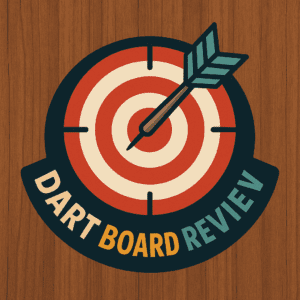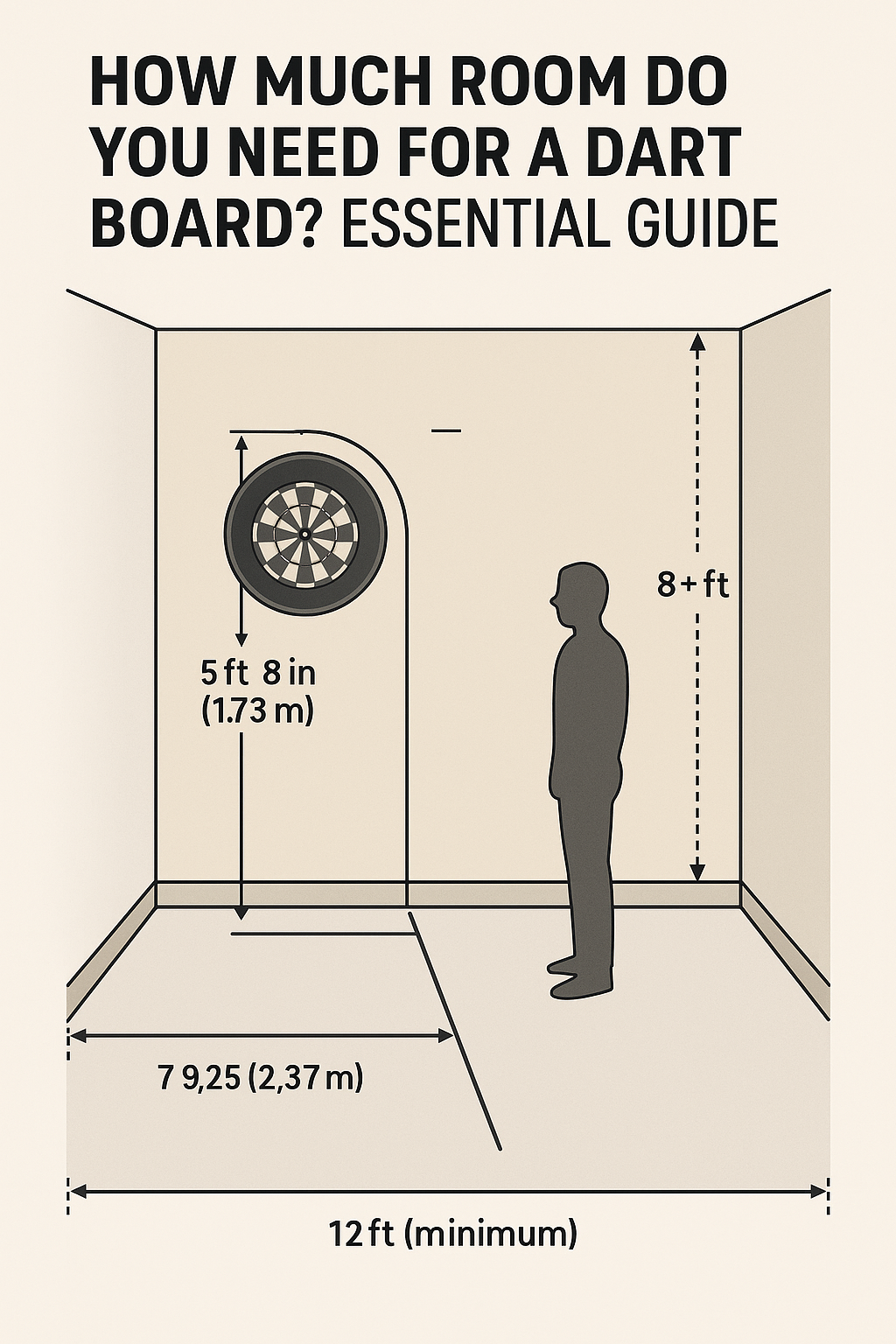Installing a dartboard isn’t as simple as hanging a board and taking a step back. The quality of your throwing space determines how accurately you play, how safe your environment is, and how long your equipment lasts. A poorly planned dart area can lead to broken darts, damaged walls, cramped movement, shadowed target zones, and incorrect muscle training that ruins your throwing form long-term.
This comprehensive guide goes far beyond basic measurements. It covers tournament standards, safety zones, lighting science, acoustics, floor protection, cabinet installation, materials, player movement physics, ceiling interference, wall compositions, and solutions for small rooms, garages, basements, outdoor setups, and even professional practice stations.
Whether you’re preparing a game room at home or creating a dedicated training corner with pro equipment like the boards featured in Best Professional Dart Boards to Buy in 2025, this guide ensures you build a space that is safe, regulation-correct, and performance-focused.
Understanding Dartboard Space Requirements
The goal of planning your dart area is not just to fit the board but to:
🔹 Allow comfortable throwing posture
🔹 Create a safe space for players & spectators
🔹 Protect surrounding surfaces (wall, floor, furniture)
🔹 Ensure accurate competitive training distances
🔹 Prevent risk from bounce-outs and ricochets
🔹 Accommodate lighting and overhead clearance
A dartboard setup is similar to a shooting range—distance, angle, stance, eye height, and target lighting all impact accuracy. If any measurement is incorrect, your brain learns inaccurate muscle memory. This is why official distances must be applied with precision, even for casual play.
Regulation Dartboard Height (Why It Matters)
Bullseye Height
5 feet 8 inches (1.73 meters)
Measured from floor to center of the bullseye.
This standard is set by the World Darts Federation (WDF) and is based on eye-level physics. The dart throw trajectory is designed to mirror the average eye alignment and dart tap-off angle used in professional throwing form.
The Science Behind the Height
The average stable throwing stance slightly lowers the eyes below shoulder level.
The arm arc requires an unobstructed straight-line release.
A higher board forces upward throw motions — causing bounce-outs.
A lower board creates downward trajectories — damaging sisal fibers faster.
Correct height maintains true parabolic flight and ensures your practice aligns with pro mechanics, especially important when using premium boards such as the winmau blade 6 dual core or other competition-level models.
Exact Throwing Distance (Oche)
Steel-Tip / Bristle Dartboards
➡ 7 ft 9.25 in (2.37 m)
Soft-Tip / Electronic Boards
➡ 8 ft (2.44 m)
Both must be measured horizontally on the floor—not from the bullseye. Measuring diagonally shortens distance by 1–2 inches, enough to alter scoring precision and ruin training.
Pro Installation Tip
Use:
A measured dart mat
A laser oche line
Permanent wall-mounted tape strip
Minimum Side Clearance and Safety
Side Space Required
➡ At least 2 ft (60 cm) of wall clearance on both sides.
Why It’s Necessary
Missed throws & bounce-outs land outside the board radius.
Cabinets need door swing clearance.
Scoreboards must be readable without crowding thrower stance.
Observers should stand outside the dart flight path for safety.
Large cabinets and heavy tournament boards like the Best dart board wall protector setups require even more lateral protection.
Ceiling Height Requirements
Minimum Ceiling Height
➡ 7 ft 9 in
Ideal Height
➡ 8–9 ft
Why Height Matters
Tall players need overhead space to fully extend arms.
Ceiling lamps and fans create collision hazards.
Shadows from overhead lighting distort depth perception.
When installing lighting, choose angled or ring lighting (see 5 Best Dartboard Lighting in 2025—Expert Reviews Inside). These reduce target shadows and produce consistent illumination across numbers and double rings.
Floor Space Behind the Oche
Minimum clearance behind throwing line:
➡ 3 ft (1 meter)
Why You Need Space Behind Players
Allows natural follow-through movement without stepping back.
Prevents collisions with observers or furniture.
Provides space for bags, darts cases (e.g., 2025’s Best Darts Cases That Make Traveling Easy), and scorekeeping areas.
Reduces risk of slips on hardwood or tile floors — use a dart mat.
Full Room Size You Need
Minimum Recommended Room Dimensions
| Space Component | Minimum Requirement |
|---|---|
| Total Room Length | 11–12 ft |
| Room Width | 6 ft minimum |
| Ceiling Height | 8 ft ideal |
| Floor Space Behind Oche | 3 ft |
| Side Safety Space | 2 ft per side |
If your space is smaller, you can still install a dart setup with lightweight soft-tip boards (see Best Bluetooth Dartboards for Smart Gaming at Home).
Wall Composition & Protection
Darts will miss the board. Even professionals misfire when practicing new throwing techniques. Protecting the wall isn’t just cosmetic—it prevents structural damage.
Best Wall Backing Materials
| Material | Advantages |
|---|---|
| Cork Sheets | Cheap, durable, self-healing |
| Wood + Foam Layer | Tournament feel, strong protection |
| Carpet Panels | Noise dampening + easy install |
| Dedicated Backboards | Professional appearance & full coverage |
Using a high-quality backing is crucial when throwing steel tips, especially with premium darts like those discussed in Best Soft Tip Dart Board: Top Picks for Every Skill Level.
Cabinet and Backboard Space
Dartboard cabinets require:
➡ Open door clearance + extra side padding
Cabinet Minimum Width
➡ Reveal width + 4–6 inches buffer
Why Cabinets Help
Hide board when not in use
Store darts safely
Improve room aesthetics
Provide scoreboard surfaces
When choosing a cabinet, avoid cheap MDF with thin hinges—they warp from dart impacts. For rugged usage, consider models reviewed in The Best Steel Tip Dart Boards to Buy In 2025.
Lighting Requirements
Proper lighting might improve your score more than buying expensive darts.
Lighting Rules
No shadows over doubles or bullseye
No direct glare in eyes
No harsh overhead spotlight
Best Lighting Options
| Light Type | Notes |
|---|---|
| LED Ring Light | Perfect, no shadow casting |
| Angled Track Lighting | Good for multi-use rooms |
| Cabinet-Integrated Light | Saves space in small rooms |
Professional players almost always use ring lighting, paired best with bristle boards like winmau blade 6 triple core dartboard.
Bounce-Out & Safety Collision Zones
Darts travel fast and ricochets can reach surprising distances.
Safety Collision Radius Around the Board
➡ 5 ft semicircle in front + 2 ft on sides
Safety Practices
Keep children & pets outside throw range
Never stand at the side edge of board
Avoid glass frames near board
Room Types & Special Adjustments
Small Bedrooms & Apartments
Use soft-tip boards
Use wall protector + mat combo
Avoid heavy tournament lighting
Garages
Best choice for bristle boards
Consider concrete wall backing
Use anti-moisture coating
Basements & Low Ceilings
Use low-profile lighting
Avoid hanging fans
Tip: Heavy cabinets add damp weight — use lightweight ones
Outdoor Installation
See full guide: How To Hang A Dartboard Outside: Expert Tips & Tricks
Final Thoughts
Building the perfect dart space isn’t just about measurements — it’s about engineering a safe, comfortable, professional practice environment that protects your home, your equipment, and your playing technique.
Following correct distances and safety margins transforms your setup from “playable” to competition-ready, especially when paired with pro gear like the options in The 5 Best Pro Dart Boards to Buy in 2025.
Whether you’re creating a casual home bar dart area or preparing to train like a professional, space discipline is the foundation of accuracy.
🎯 Measure once. Install right. Throw forever.


